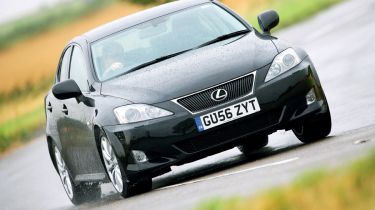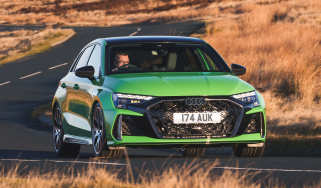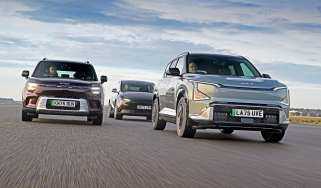Lexus IS250
Traditionally, the first ports of call for anyone wanting a prestige sports saloon were BMW, Audi and Mercedes.
Traditionally, the first ports of call for anyone wanting a prestige sports saloon were BMW, Audi and Mercedes. But you can now add Lexus to
that list. The premium spin-off from Toyota first introduced the IS range to the UK in 1999 and quickly established itself as a strong contender.
The second-generation model has further enhanced the firm’s reputation, and although brand image may not quite be up to Mercedes standards yet, the Japanese firm isn’t far behind. Styling is a key factor and the IS boasts a definite European flavour to its lines.
We’re not totally convinced by the shape, though. While the sharp nose looks good and the high waistline gives a solid air, the rather large rump seems ungainly and the tail-lights aren’t particularly stylish. It’s distinctive, although not quite as memorable as the athletic Mercedes.
But while the appearance is European, the interior is typically Japanese. There are some disappointing similarities with Toyota models, and the silver plastics on the centre console feel dated, even if the layout is simple and the controls intuitive. The standard leather trim is plush and build quality is a match for the Merc, but while everything is more tactile than in the C-Class, there are some big criticisms.
The seating is too high, restricting headroom for taller drivers, there’s a lack of storage on the centre console and some of the buttons are hidden away at knee level. And it’s no better in the back. Head and legroom aren’t great and footspace is tight, limited further by the large transmission tunnel. The boot is also very small.
However, push the engine start button, and things improve. The 2.5-litre V6 powerplant is one of the smoothest we’ve ever driven. There’s virtually no vibration, and noise is well suppressed.
At the test track, the Lexus was almost a second quicker from 0-60mph, with a sprint time of 8.1 seconds, although it was only marginally faster in kickdown. The reason for this is that while its 252Nm of torque beats the C200K’s 250Nm, it doesn’t peak until 4,800rpm – 2,000rpm further up the rev range than the Mercedes. So in everyday conditions, the IS seems a little sluggish, which isn’t helped by its extra kerbweight. The six-speed automatic box doesn’t provide much feedback, either, although the upshifts are virtually seamless.
Refinement is the IS’s strong point. Great insulation means the cabin is silent at speed, and although there is tyre noise on the motorway, it makes a superb long-distance cruiser. At idle, the IS was 3dB quieter than the C-Class’s 41dB, and it was also more hushed at 70mph. The ride is excellent, too, even if the rear suspension can become slightly unsettled on uneven roads.
The handling isn’t as involving as the Mercedes’, but it’s well balanced, and the IS feels agile. It’s let down somewhat by the electric power-steering, which is artificial and lacks feedback, but body roll is kept in check.
The Lexus isn’t cheap, though. At nearly £30,000, it carries a hefty premium over the C-Class. The options list isn’t as extensive as the Merc’s and kit is pretty expensive, too. For example, sat-nav will set you back £2,710, but that also includes parking sensors and Bluetooth. Will this high price count against it at the final verdict?
Details
Price: Price: £29,627
Model tested: Lexus IS250 SE-L Auto
Chart position: 2
WHY: The IS has broken German domination of the sector, thanks to high kit levels and superb comfort.
Economy
The V6 Lexus was the slightly thirstier car. But a 26.1mpg average is still fairly respectable, and on motorways this rose to 33mpg. However, it will go 60 fewer miles between fill-ups.
Residuals
The flagship IS250 SE-L will be worth £13,006 in three years – or 43.9 per cent of its price new. It’s the hardest hit car in the range; diesels are a better choice for strong values.
Servicing
If you want top customer service, buy a Lexus. Not only does work cost less than on the C-Class, but it came first in our 2007 Driver Power poll for the sixth year in a row.
Tax
With a higher list price, plus a CO2 output 27g/km higher, the IS250 costs fleet drivers more. The annual standard-rate bill is £2,086 – that’s £517 a year more than for the C200K.



